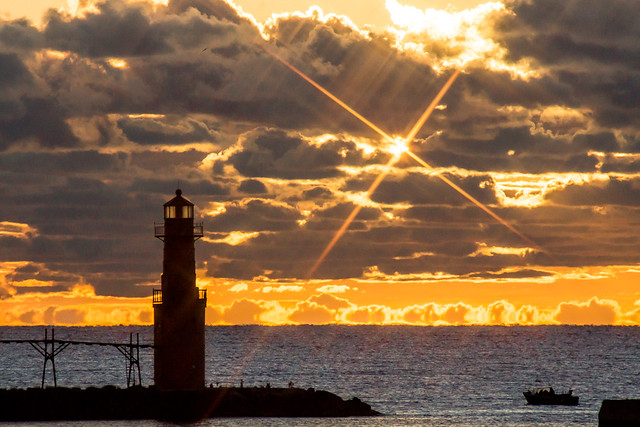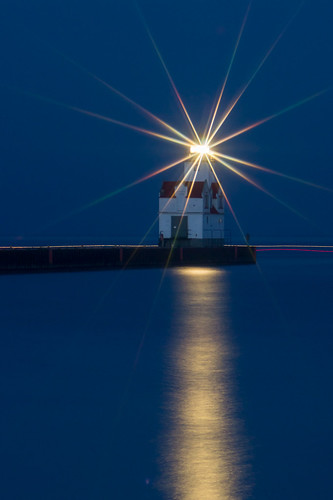Star Filter
The Sun’s Warm Embrace

The sun seemed to be wrapping it’s fingers around the Kewaunee, Wisconsin lighthouse for a warm hug as it rose over Lake Michigan.
When I am catching a sunrise at a lighthouse setting, I often try to get the sun to line up right behind the lighthouse to create a great silhouette effect. The camera settings and a telephoto lens helped to create a star burst effect at the points were the sun was peeking around the edges of the lighthouse.
I like the tone and the silhouette effect here. The flying birds and the sitting fisherman’s silhouette (to the right of the lighthouse) were an added bonus.
To see more of the finer details, click on the photo. When you do, a full-screen version will open in a new browser tab.
All of the photos I post are available for purchase. If you’d like to buy one, click on the blue “Buy this Online” bar below for a variety of print and frame options or contact me (pops@popsdigital.com) for digital purchase and licensing options.
Star Bright
I went out to photograph a full moon…but ended up focusing on a star.
This is a long exposure, early evening view of the Kewaunee, Wisconsin Lighthouse. This is not the shot I was going for, but that’s the way it works sometimes.
I’d been watching the lunar calendar and decided the best evening to capture the full moon rising over Lake Michigan would be Friday. When it was time to head for the beach, I noticed a band of clouds in the sky but thought they might be high enough to not block the horizon. Turns out, there was enough “atmosphere” between me and the moon, I didn’t see it until much later in the night.
Since I was at the beach and had everything set up, I thought I’d fiddle around getting a night shot of the lighthouse. While fiddling, I thought the star filter I have might add a nice effect to the bright lighthouse light. The star filter is threaded so you can screw it on to the end of the lens. It creates an X pattern over any bright light source in the photo’s frame. I’ve often wanted more lines then the four it’s designed to create, but it is what it is. …or is it?
I took the star filter off the lens and decided to try and just hold it very still, by hand, in front of the lens. That worked better than expected. Next I took a shot and held the filter still it for a few seconds and rotated it a few degrees and, again, held it still. That gave me more points to the star…and it looked pretty good. I experimented a bit more to end up with this version.
This is a 20-second exposure. (20-sec, f/11, ISO 200) I was holding the filter in front of the lens – as close as I could without actually touching the lens. When I tripped the shutter (with a remote), I would count to five, rotate the filter, count to five, rotate the filter, count to five and quickly remove the filter for the remainder of the exposure. As you can see, that gave me three separate sets of star points.
Let me point out a few other interesting effects from the long exposure time. The lake wasn’t as smooth as it seems in this image. The long exposure has a tends to smooth out any motion. You might also notice a small, dark, oblong spot near the corner of the pier, just to the right of the lighthouse. That is actually a man who was fishing off the pier. He moved enough over the 20-seconds that all you see is a blur. And finally, there are a couple of thin lines of light that run horizontal through the frame…about level with the deck of the pier. Those are lights from a boat that was leaving the harbor, traveling left to right over the span of the 20-second exposure.
To view a larger version of this image, click on the image.
Morning Star

The sun was fighting to peek through the clouds as it rose over Lake Michigan and the lighthouse and harbor of Algoma, Wisconsin.
The sharp lines extending from the bright sunlight was achieved by using a Star Filter on the camera lens. Because of the cloud cover, this scene was rather dark when I captured. That’s also why there is a lot of camera noise (that grainy look) after brightening it with photo software.
To view a larger version, click on the photo.



















































